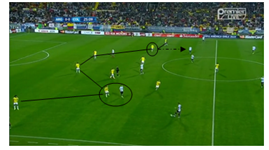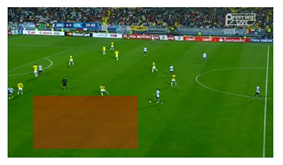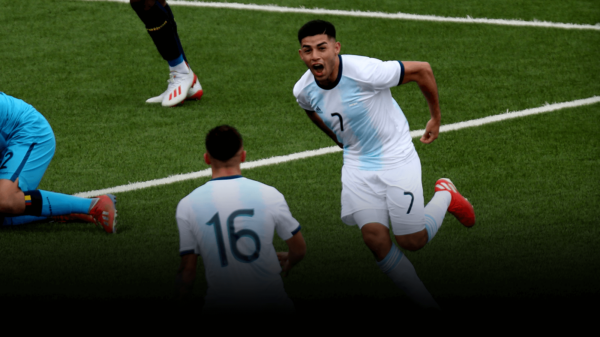In another battle between two giants of South American football, Argentina squared up against Colombia with the tantalising prospect of a possible semi-final clash with Brazil. Gerardo Martino’s men were tipped by many to go all the way in the competition and have looked on course to do so, though they are still yet to hit their stride. Colombia, on the other hand, have underwhelmed throughout the competition, scraping through to the quarter finals and scoring just one goal in their first three games.
One would imagine that a team containing world-class attacking firepower in the form of Radamel Falcao, James Rodriguez and Jackson Martinez would have blown many teams in the competition away and challenged the likes of Argentina and Brazil for Copa America glory. This game saw a continuation of the mediocrity that has been exhibited by Colombia, who had their goalkeeper David Ospina to thank after he pulled off a string of fine saves to take the game to penalties.
Argentina 0-0 Colombia (5-4 pens)

Line Ups
Argentina (4-2-3-1): 1. Romero // 4. Zabaleta, 2. Garay, 17. Otamendi, 16, Rojo // 6. Biglia, 14. Mascherano // 10. Messi, 21. Pastore, 7. Di Maria // 11. Aguero
Colombia (4-2-2-2): 1. Ospina // 18. Zuniga, 2. Zapata, 22. Murillo, 4. Arias // 15. Mejia, 10. Rodriguez // 11. Cuadrado, 16. Ibarbo // 19. Gutierrez. 21. Martinez
Substitutions: 73’ Tevez (Aguero), 77’ Banega (Pastore), 87’ Lavezzi (Di Maria) // 24’ Cardona (Gutierrez), 74’ Falcao (Martinez), 86’ Muriel (Ibarbo)
Colombia sit back, Mascherano takes advantage
After a hard-fought 1-0 win against Brazil thanks to their brilliant counter-pressing, it was assumed that Colombia would continue with this against the Argentinians; however after witnessing what Lionel Messi has produced when faced against teams that press with a high line (Pep Guardiola knows this all too well), Colombia decided to drop off and concede space in the midfield third for the most part, preferring to form a more compact and cohesive unit in the defensive phase. Instead of pressing for 90 minutes with the ferocious intensity as in the Brazil game, they adopted a more patient approach, pressing sporadically and defending in a medium block, waiting for triggers before initiating the press.

Colombia in defensive shape, only begin to press when Mascherano receives ball; although a fair amount of space is conceded between the lines.
Despite a decreased ferocity in Colombia’s pressing, Argentina still ran a high risk of conceding possession in their defensive third; therefore they were lucky that they had Javier Mascherano in the pivot role, who was sublime in this fixture. People often forget what an excellent defensive midfielder he is due to him being shunted to a centre-back role at Barcelona because of the excellent Sergio Busquets. He was the key to Argentina’s stability in possession, with smart positioning in between the CBs and in the half-spaces in order to find space and dictate play from deep. The acres of space he found himself in allowed his magnificent ball-playing ability to be showcased, a prime example of this being in the 26th minute when he played a superb cross-field ball to Javier Pastore out wide, who set up Aguero for a 1v1 only to be denied once again by Ospina. The next two images exemplify his performance and positioning.
In the first image, he drops into the right half-space creating a 4v3 overload for Argentina. This allows the full-backs, Rojo and Zabaleta to push forward and force back Colombia wingers Cuadrado and Ibarbo. It also gives Argentina the stability they so desperately need in the construction phase of possession as they have the spare man at the back. His half-space positioning is significant as it draws Jackson Martinez towards him, creating space in the centre for Biglia. The 2nd image is another prime example of Mascherano’s tactical nous. He positions himself between the CBs (Garay and Otamendi), however he deliberately decides to stay much deeper than the both of them. This makes it more difficult for Colombia’s attacking players to successfully press the Argentina back line as there is now a larger distance they must cover thanks to Mascherano’s depth in the defensive line. If they do decide to press, Argentina will still be in an advantageous situation as the CBs are ahead of Mascherano, providing him with good support angles thus allowing Argentina to progress into the midfield third with ease.
Colombia’s defensive minded wingers and man-marking in wide areas
Being the former manager of Argentina, Jose Pekerman was well aware of the threat they posed in the wide areas. He instructed his wingers to track the Argentina full-backs all the way, with Colombia’s own full-backs situated very, very narrowly. At times they were often seen forming a back 6. It was intriguing how negative they set up in the 2nd defensive phase and it had a direct effect on their transitions. This was in stark contrast to the Brazil game where they were intent on breaking in the wide areas, using their wingers or strikers as an outlet. In this game the Colombia wingers were often in absurdly deep positions when Colombia regained possession, meaning that Colombia were left without an outlet when attacking.

Messi, as expected, was Argentina’s main attacking threat wreaking havoc when given freedom to roam from the right and cutting in on his left foot. Santiago Arias was deployed as an inverted wing-back, playing as a left-back despite being right-footed, in order to contain Messi; which is for many people the most effective way of stifling the threat of an inverted winger. However, Messi is no ordinary inverted winger. Arias’ man-marking of Messi proved futile as he roamed freely and occasionally rotated positions with Javier Pastore, bamboozling the Colombian defensive organisation. Arias was reluctant to follow Messi all the way as Colombia would surely have been undermanned at the back and spaces would open up in the channels for Aguero to exploit.
With their wingers penned back so deep, Colombia conceded vast amounts of room in the half-spaces. With the half-spaces completely vacated by the Colombia wingers, the Argentina players had plenty of space in which to drop deep and bring the ball into the next stage of possession. The half-space positioning proved dangerous for Colombia as players were dragged out of position and space was created in the centre. The back 6 proved very ineffective as the midfield battle was often lost, Argentina had substantial overload when constructing possession and bringing the ball into the final 3rd.
These images indicate very clearly the problems caused by the deep positioning of the Colombia wide men. In the first image, Argentina’s wide men, Messi, Pastore and Rojo (circled) are all being marked by Colombia players. This causes problems for Colombia however as the wingers do not have access to Otamendi in possession, and are therefore unable to initiate pressing. Otamendi has all the time in the world to bring out the ball from the back and run a fair distance. Whereas in a conventional 4-4-2 defensive shape the wingers are situated on the same line as the central midfielders, in this back 6, the wingers are substantially deeper, meaning the Colombian double pivot has a ridiculous amount of space in which to cover.
James in deeper role proves problematic for Colombia
Many people questioned Pekerman’s logic in starting arguably Colombia’s most dangerous attacking threat in a deeper role. Nonetheless, this decision was forced upon him due to the suspension of Carlos Sanchez, who was phenomenal in Colombia’s 1-0 victory over Brazil. James deputised for Sanchez in this fixture, unfortunately though he is nowhere near as competent at performing such a role. Often times he would venture too high up the field to join the attack but also to cover the space, partly as a result of poor staggering from Colombia, in stark contrast to the Brazil game, and due to his natural attacking instinct. This had the knock-on effect on the Colombia defence as his midfield partner, Mejia was obligated to cover the space which he left behind. Situated on the right side, it was exactly that area which was targeted by Argentina in attacking transitions. Messi exploited this space constantly, dragging Mejia out of position and drawing fouls, he won 8 during the game, far more than any other player. Being accustomed to playing against parked buses on a weekly basis, la Pulga was having a field day at times, enjoying plenty of time and space to run at the Colombia back 4. Pekerman realised this almost instantaneously and rectified the problem in the 24th minute, substituting Teo Gutierrez and replacing him with the more defensive-minded Edwin Cardona.
Where does this leave them?
Another brilliant yet goal-less performance from Lionel Messi has seen Argentina progress to the last 4 of the competition, going one better than their dismal showing in the 2011 edition of the Copa America. However for a country which has produced some of the greatest players ever to have graced the game, a semi-final place is not enough. Expectations are high as the Albiceleste go in search of international glory for the first time since 1993.
For Colombia, despite having the excuse of being pitted against two of the biggest teams in South American football, their performance was still well below par. Many reasons acquit to their abject failure to perform as expected, however the bottom line is that one solitary goal in the entire tournament scored by one of their centre-backs no less, is abysmal considering their incredible depth in attacking positions. All is not lost though, this is still a young side with a host of quality players who could still make their mark on World and South American football in the coming years.
For more reading on the Copa America, head this way.
Written by Miles Olusina
- Scout Report: Marcus Thuram | Gladbach’s attacking sensation - July 17, 2020
- Tactical Philosophy: Paulo Fonseca - May 28, 2020
- Maurizio Sarri at Chelsea: Tactical Approach & Key Players - September 5, 2018



































































